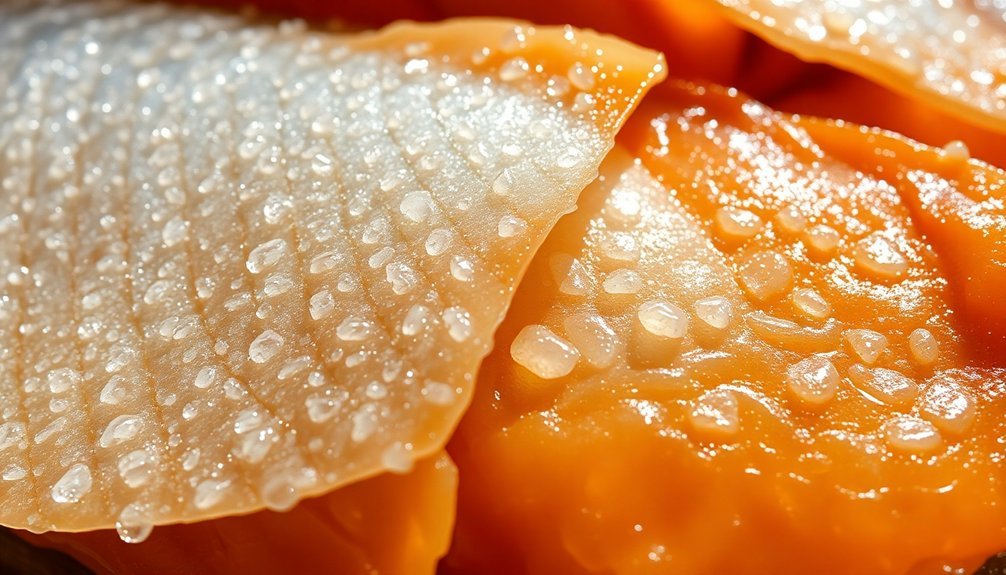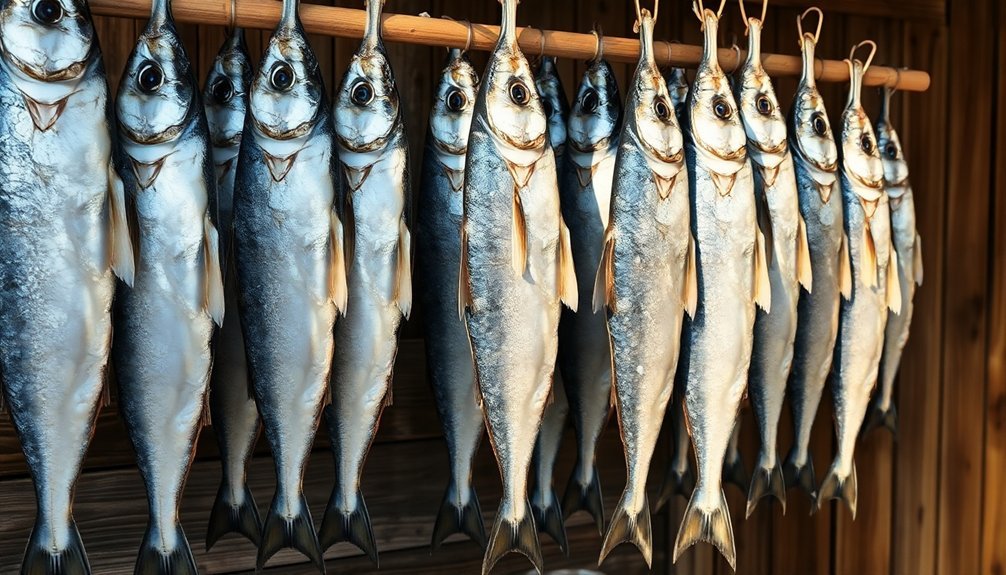Air-dried fish tastes uniquely rich because the drying process naturally concentrates and intensifies its flavors. When moisture evaporates, it leaves behind concentrated proteins and omega-3 fatty acids, making each bite more flavorful than fresh fish. You'll notice this intensification happens through both enzymatic reactions and chemical changes that occur during the drying process, creating complex flavor profiles you can't get from other preservation methods. Traditional drying techniques, whether through sun exposure or air circulation, also play a vital role in developing these distinct tastes. Understanding the science and cultural significance behind this age-old preservation method reveals even more layers to its unique richness.
The Science Behind Drying Fish

While the art of drying fish dates back thousands of years, the science behind it reveals a fascinating process of preservation through moisture control. When you dry fish, you're fundamentally creating an environment where harmful bacteria can't thrive by removing the moisture they need to survive.
The process centers on reducing water activity (a_w), which makes water less accessible to microorganisms. You'll find that this preservation method works through two main mechanisms: direct moisture removal through air exposure and the addition of salt, which draws water out of the fish muscle while creating an inhospitable environment for bacteria. These techniques have proven so effective that properly dried fish can have a storage life of years.
During drying, you're not just removing water – you're triggering complex chemical changes. The process transforms proteins and deactivates enzymes, while controlled dry aging breaks down proteins and connective tissues.
These changes aren't just about preservation; they're vital to developing the fish's rich, concentrated flavors and distinctive texture. Whether you're using traditional wooden racks for stockfish or modern forced-air methods, the key lies in maintaining proper temperature, airflow, and protection from pests to guarantee ideal drying conditions.
From Ocean Fresh to Concentrated
Four remarkable changes occur as fish transforms from its ocean-fresh state to dried form. As moisture evaporates, you'll notice the fish's texture becoming firmer while its natural flavors intensify. This concentration process isn't just about taste – it's an essential transformation that preserves the fish by inhibiting bacterial growth that typically causes spoilage in fresh fish. The drying method originated in coastal Asian communities as a preservation technique.
What you're tasting in air-dried fish isn't just concentrated flavor; it's also a dense package of nutrients. The drying process concentrates proteins and preserves valuable omega-3 fatty acids, making each bite more nutritionally rich than its fresh counterpart. You'll find that vitamin D and other essential nutrients become more concentrated as water content decreases.
The transformation process creates complex flavor profiles through enzymatic reactions during drying. If you're comparing different dried fish products, you'll notice variations in taste based on the drying method used. Solar drying, air drying, and freeze-drying each produce distinct results, while factors like salt content and drying duration further influence the final flavor.
The key to achieving that uniquely rich taste lies in proper handling and precise drying conditions.
Time and Temperature Matter

The art of achieving concentrated fish flavors depends heavily on precise timing and temperature control. You'll find that drying durations can vary dramatically, from just a few hours for simple sun-dried varieties like labtingaw to several months for traditional stockfish. Each method demands its own specific timeline to reach ideal flavor concentration. In Italy, dried cod and baccalà are interchangeable in many traditional recipes.
Temperature control plays an essential role in how your fish's flavors develop. While traditional methods rely on ambient conditions, modern techniques offer precise control through automated equipment. You'll notice that different approaches yield distinct results – freeze-drying preserves the original taste profile, while air drying concentrates flavors naturally.
If you're using boiling-drying methods, you'll start with high temperatures before letting the fish dry at room temperature.
When you get the timing and temperature right, you'll achieve that perfect balance of texture and taste. However, if you dry your fish too long, you'll lose vital oils and flavors. Conversely, insufficient drying time leads to spoilage.
The process you choose impacts the final product considerably – salting before drying enhances flavor intensity, while air drying without salt produces milder results.
Traditional Drying Methods
Traditional methods of drying fish have evolved over centuries, each offering unique advantages for preserving and enhancing flavor. You'll find that sun drying and air drying remain popular choices in regions where climate conditions permit, with sun-dried fish developing intense flavors under direct sunlight while air-dried varieties benefit from constant wind exposure.
When you're exploring traditional drying techniques, you'll notice three distinct approaches that create unique taste profiles:
- Sun drying requires you to lay cleaned fish on racks in sunny areas, turning them periodically for even moisture removal and flavor development.
- Air drying involves hanging fish in well-ventilated spaces, often using wooden trellises or bamboo skewers to guarantee proper circulation.
- Smoking combines drying with flavor infusion, requiring you to brine the fish before exposing it to wood smoke.
Modern dehydrator drying offers you precise control over temperature and airflow, making it a reliable alternative to weather-dependent methods.
While each technique impacts the final taste differently, they all work toward the same goal: removing moisture while concentrating the fish's natural flavors. You'll find that traditional methods often produce more complex taste profiles due to their slower, more natural processes.
Cultural Impact on Taste Development

Cultural preferences for air-dried fish emerge from deeply rooted family backgrounds and social structures, with genetic factors and shared environments explaining more than half of people's taste preferences.
You'll likely find that your appreciation for air-dried fish's distinct flavor is greatly influenced by your family's culinary traditions and early exposure to these foods.
Your social class and cultural background play vital roles in shaping how you perceive and appreciate air-dried fish.
If you've grown up in communities where air-dried fish is a staple, you'll naturally develop a more sophisticated understanding of its subtle flavor nuances. This appreciation becomes part of your cultural capital, helping you connect with others who share similar taste preferences.
You'll notice that your community's support and access to traditional food sources strongly impact your relationship with air-dried fish.
When you share these foods within your cultural group, you're not just enjoying a meal – you're participating in a broader expression of cultural identity.
The availability of air-dried fish in your community can greatly affect how you maintain and develop your taste for this traditional food.
Frequently Asked Questions
Can Air-Dried Fish Be Safely Consumed by Pregnant Women?
You can safely eat air-dried fish during pregnancy if it's low in mercury and properly cooked to 145°F. Stick to options like anchovies and salmon, but avoid high-mercury fish like shark or swordfish.
What Are the Best Storage Containers for Preserving Air-Dried Fish?
You'll want to store your air-dried fish in vacuum-sealed bags or airtight glass mason jars. For best results, use containers with tight seals and consider adding desiccants to control moisture during storage.
How Can You Tell if Air-Dried Fish Has Gone Bad?
You'll know air-dried fish has spoiled if you notice dark patches, mold growth, or a slimy texture. Watch for ammonia-like smells, sour odors, and soft flesh that doesn't spring back when pressed.
Does Air-Dried Fish Need to Be Refrigerated After Opening?
Yes, you'll need to refrigerate air-dried fish after opening to maintain freshness. Store it in an airtight container or resealable bag. If you're planning to keep it longer than a week, refrigeration is essential.
Can You Make Air-Dried Fish Using Frozen Fish as Starting Material?
Yes, you can use frozen fish for air-drying, but it must be high-quality and properly thawed first. You'll need to handle it carefully to maintain texture and taste during the drying process.
In Summary
You'll find that air-dried fish's rich taste comes from a perfect balance of science and tradition. As moisture evaporates, flavors concentrate and proteins break down, creating that distinctive umami punch you love. Whether it's Norwegian stockfish or Asian dried seafood, the slow drying process enhances natural compounds while developing new flavor notes. You're tasting centuries of culinary wisdom combined with nature's own preservation method.





Leave a Reply